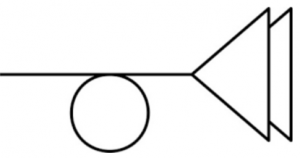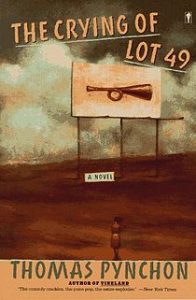The Crying of Lot 49 and Real-World Conspiracy
Christina Bagni//Blog Writer
The Crying of Lot 49 is a fascinating book by Thomas Pynchon that focuses on conspiracy and paranoia. Oedipa’s unravelling of a maybe-secret society ends with (spoiler) little concrete resolution, as from page 1 to the final moments the reader is never sure whether Oedipa has stumbled into a super-secret underground government resistance group or is simply going insane with paranoia.
The source of Oedipa’s obsession is her deceased ex-boyfriend’s stamp collection, a small clue which leads her from one place to another in search of the meaning behind the symbol of a muted trumpet, drawn in-book to look something like this:

She starts seeing the trumpet everywhere, from graffiti on restroom walls to tattoos on passers-by. Over time she comes to believe it is an underground mail system, run by people who have things to hide from the government.
This is so important to modern-day readers. If the NSA and Edward Snowden have taught us anything, Oedipa wasn’t too far from the mark. Sure, her story takes place in the 1960’s, but here in the 2010’s we have legitimate proof that the government reads our mail, listens to our phone calls, and tracks our online activity. Nowadays it’s considered uninformed if you don’t cover your webcam with a piece of tape, because it’s common knowledge that someone is probably watching you.

Unlike Dan Brown novels with clues etched in the color scheme of old paintings or online memes highlighting Illuminati triangles in dollar bills, the NSA “conspiracy” was proved correct. Many conspiracies, over time, have been proved to be true—take MK Ultra, revealed to have been a project in which the CIA had been testing LSD and other drugs on prisoners, the mentally challenged, and their own employees for years. The uncovering of such giant scandalous networks such as the NSA and malicious government projects such as MK Ultra make it easy to believe in the realism of a system such as Trystero. In today’s world, it is not so impossible to come to the conclusion that Oedipa has truly discovered something huge.
Or…has she? After all, for every true conspiracy there are dozens of false ones. Some people say the moon landing was a hoax or that Finland isn’t real, and those can easily be discredited as ridiculous. An easy test for the validity of a conspiracy is thinking about the likelihood of so many people keeping the secret. The CIA keeping something secret is believable—they’re trained for it, and half of them are spies, so, sure. All of Scandinavia and every government in the world pretending that Finland exists when it actually doesn’t? Less believable to say the least.
The clues Oedipa discovers leave the reader somewhat in the middle, perpetually debating the believability of the existence of Trystero. In the end, I came to the conclusion that while Trystero may not be as big a deal as Oedipa thinks, it is unlikely that all the clues she found would exist without something tying them together.
 If you’ve read The Crying of Lot 49 and don’t quite agree, or even if you haven’t and would like a taste of the mystery, open up your iPhone and check out your emoji keyboard. In the mail/envelope section, you will find a horn, alone, separate from the other musical instruments. Is this an Easter egg from a Pynchon fan, or a secret promise that, like Trystero, iPhones will not monitor your conversations? Is this a sign of a secret society growing into real life from a fictional beginning, or a mistake on the developer’s part? Is it a coincidence, or a clue? Is it a conspiracy, or are we just paranoid? Check out The Crying of Lot 49 and get back to me.
If you’ve read The Crying of Lot 49 and don’t quite agree, or even if you haven’t and would like a taste of the mystery, open up your iPhone and check out your emoji keyboard. In the mail/envelope section, you will find a horn, alone, separate from the other musical instruments. Is this an Easter egg from a Pynchon fan, or a secret promise that, like Trystero, iPhones will not monitor your conversations? Is this a sign of a secret society growing into real life from a fictional beginning, or a mistake on the developer’s part? Is it a coincidence, or a clue? Is it a conspiracy, or are we just paranoid? Check out The Crying of Lot 49 and get back to me.

What was the name of the company? Aerodyne?